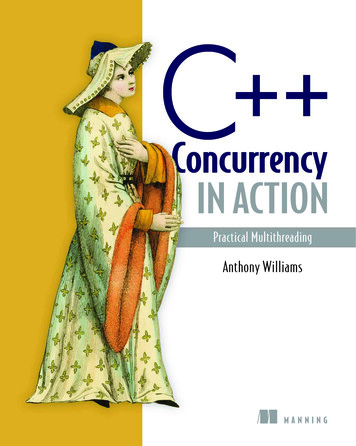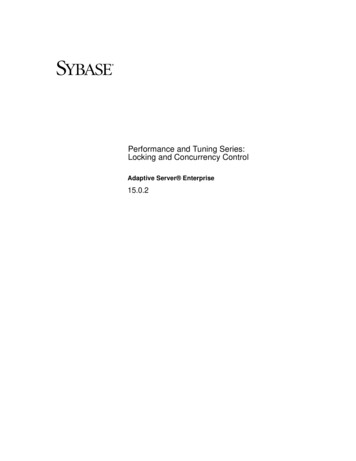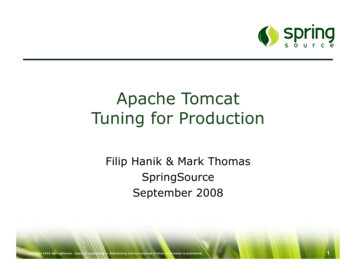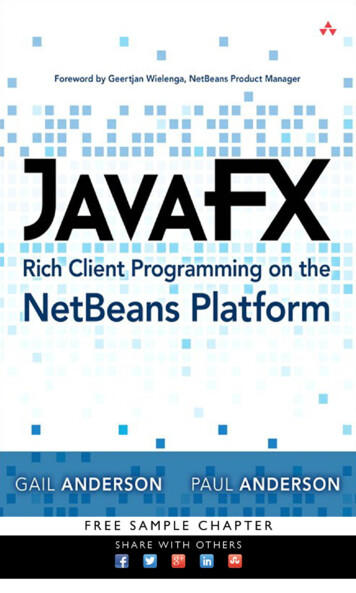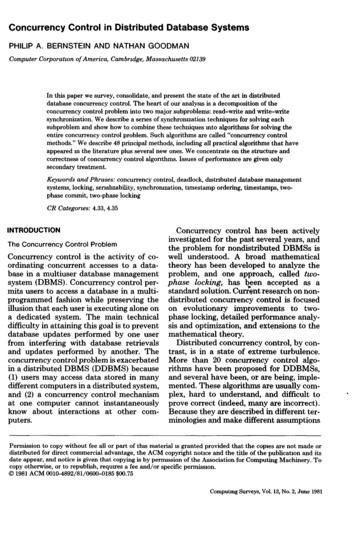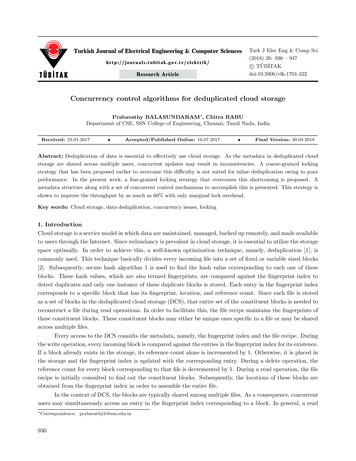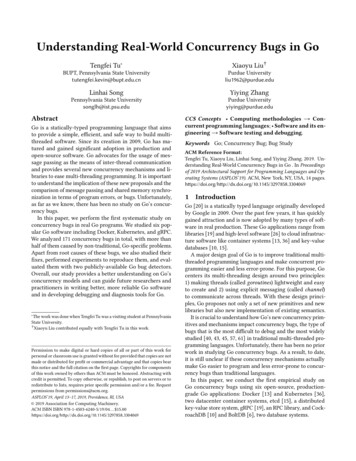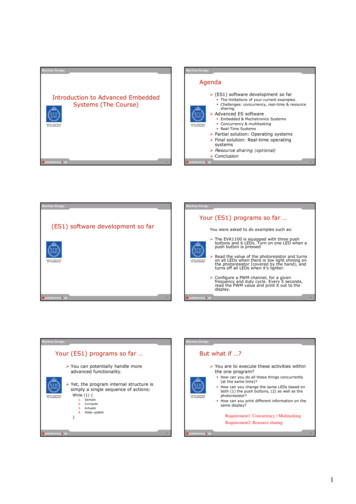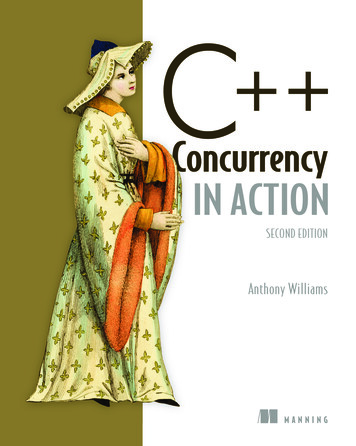
Transcription
IN ACTIONSECOND EDITIONAnthony WilliamsMANNING
Praise for the first edition“It’s not just the best current treatment of C 11’s threading facilities . it’s likely toremain the best for some time to come.”—Scott Meyers, author of Effective C and More Effective C “Simplifies the dark art of C multithreading.”—Rick Wagner, Red Hat“Reading this made my brain hurt. But it’s a good hurt.”—Joshua Heyer, Ingersoll Rand“Anthony shows how to put concurrency into practice.”—Roger Orr, OR/2 Limited“A thoughtful, in-depth guide to the new concurrency standard for C straight fromthe mouth of one the horses.”—Neil Horlock, Director, Credit Suisse“Any serious C developers should understand the contents of this important book.”—Dr. Jamie Allsop, Development Director
C Concurrencyin ActionSecond EditionANTHONY WILLIAMSMANNINGSHELTER ISLAND
For online information and ordering of this and other Manning books, please visitwww.manning.com. The publisher offers discounts on this book when ordered in quantity.For more information, please contactSpecial Sales DepartmentManning Publications Co.20 Baldwin RoadPO Box 761Shelter Island, NY 11964Email: orders@manning.com 2019 by Manning Publications Co. All rights reserved.No part of this publication may be reproduced, stored in a retrieval system, or transmitted, inany form or by means electronic, mechanical, photocopying, or otherwise, without prior writtenpermission of the publisher.Many of the designations used by manufacturers and sellers to distinguish their products areclaimed as trademarks. Where those designations appear in the book, and ManningPublications was aware of a trademark claim, the designations have been printed in initial capsor all caps.Recognizing the importance of preserving what has been written, it is Manning’s policy to havethe books we publish printed on acid-free paper, and we exert our best efforts to that end.Recognizing also our responsibility to conserve the resources of our planet, Manning booksare printed on paper that is at least 15 percent recycled and processed without the use ofelemental chlorine.Manning Publications Co.20 Baldwin RoadPO Box 761Shelter Island, NY 11964Development editors:Technical development editor:Review editor:Production editor:Copy editors:Proofreader:Technical proofreader:Typesetter:Cover designer:ISBN: 9781617294693Printed in the United States of America1 2 3 4 5 6 7 8 9 10 – SP – 24 23 22 21 20 19Cynthia Kane, Jennifer StoutAlain CouniotAleksandar DragosavljevićJanet VailSafis Editing, Heidi WardMelody DolabFrédéric FlayolDennis DalinnikMarija Tudor
To Kim, Hugh, and Erin
brief contents1 Hello, world of concurrency in C ! 12 Managing threads 163 Sharing data between threads 364 Synchronizing concurrent operations 725 The C memory model and operations onatomic types 1246 Designing lock-based concurrent data structures 1737 Designing lock-free concurrent data structures 2058 Designing concurrent code 2519 Advanced thread management10 Parallel algorithms 32711 Testing and debugging multithreaded applications 339vi300
contentspreface xiiiacknowledgments xvabout this book xviiabout the author xxabout the cover illustration xxi1Hello, world of concurrency in C ! 11.1What is concurrency?2Concurrency in computer systems 2 Approaches toconcurrency 4 Concurrency vs. parallelism 6 1.2Why use concurrency?7Using concurrency for separation of concerns 7 Usingconcurrency for performance: task and data parallelism 8When not to use concurrency 9 1.3Concurrency and multithreading in C 10History of multithreading in C 10 Concurrency support in theC 11 standard 11 More support for concurrency andparallelism in C 14 and C 17 12 Efficiency in the C Thread Library 12 Platform-specific facilities 13 1.4Getting started13Hello, Concurrent World 14vii
CONTENTSviii2Managing threads 162.1Basic thread management 17Launching a thread 17 Waiting for a thread to complete 20Waiting in exceptional circumstances 20 Running threads inthe background 22 2.22.32.42.53Passing arguments to a thread function 24Transferring ownership of a thread 27Choosing the number of threads at runtime 31Identifying threads 34Sharing data between threads 363.1Problems with sharing data between threads 37Race conditions 383.2 Avoiding problematic race conditions39Protecting shared data with mutexes 40Using mutexes in C 41 Structuring code for protecting shareddata 42 Spotting race conditions inherent in interfaces 44Deadlock: the problem and a solution 51 Further guidelinesfor avoiding deadlock 53 Flexible locking withstd::unique lock 59 Transferring mutex ownership betweenscopes 61 Locking at an appropriate granularity 62 3.3Alternative facilities for protecting shared data 64Protecting shared data during initialization 65 Protecting rarelyupdated data structures 68 Recursive locking 70 4Synchronizing concurrent operations 724.1Waiting for an event or other condition 73Waiting for a condition with condition variables 74Building a thread-safe queue with condition variables 764.2Waiting for one-off events with futures 81Returning values from background tasks 82 Associating a taskwith a future 84 Making (std::)promises 87 Saving anexception for the future 89 Waiting from multiple threads 90 4.3Waiting with a time limit 93Clocks 93 Durations 94that accept timeouts 98 Time points96 Functions
CONTENTS4.4ixUsing synchronization of operations to simplify code 99Functional programming with futures 99 Synchronizingoperations with message passing 104 Continuation-styleconcurrency with the Concurrency TS 108 Chainingcontinuations 110 Waiting for more than one future 114Waiting for the first future in a set with when any 115Latches and barriers in the Concurrency TS 118 A basic latchtype: std::experimental::latch 118 std::experimental::barrier:a basic barrier 120 std::experimental::flex barrier—std::experimental::barrier’s flexible friend 121 5The C memory model and operations on atomic types 1245.1Memory model basics 125Objects and memory locations 125 Objects, memory locations,and concurrency 126 Modification orders 127 5.2Atomic operations and types in C 128The standard atomic types 128 Operations onstd::atomic flag 132 Operations on std::atomic bool Operations on std::atomic T* : pointer arithmetic 137Operations on standard atomic integral types 138The std::atomic primary class template 138Free functions for atomic operations 140 134 5.3Synchronizing operations and enforcing ordering142The synchronizes-with relationship 143 The happens-beforerelationship 145 Memory ordering for atomic operations 146Release sequences and synchronizes-with 164 Fences 166Ordering non-atomic operations with atomics 168 Orderingnon-atomic operations 169 6Designing lock-based concurrent data structures 1736.1What does it mean to design for concurrency?174Guidelines for designing data structures for concurrency6.2175Lock-based concurrent data structures 176A thread-safe stack using locks 176 A thread-safe queue usinglocks and condition variables 179 A thread-safe queue usingfine-grained locks and condition variables 183 6.3Designing more complex lock-based data structures 194Writing a thread-safe lookup table using locks 194thread-safe list using locks 199 Writing a
CONTENTSx7Designing lock-free concurrent data structures 2057.1Definitions and consequences 206Types of nonblocking data structures 206 Lock-free datastructures 207 Wait-free data structures 208 The pros andcons of lock-free data structures 208 7.2 Examples of lock-free data structures 209Writing a thread-safe stack without locks 210 Stopping thosepesky leaks: managing memory in lock-free data structures 214Detecting nodes that can’t be reclaimed using hazard pointers 218Detecting nodes in use with reference counting 226 Applying thememory model to the lock-free stack 232 Writing a thread-safequeue without locks 236 7.3Guidelines for writing lock-free data structures 248Guideline: use std::memory order seq cst for prototyping 248Guideline: use a lock-free memory reclamation scheme 248Guideline: watch out for the ABA problem 249 Guideline:identify busy-wait loops and help the other thread 249 8Designing concurrent code 2518.1Techniques for dividing work between threads 252Dividing data between threads before processing begins 253Dividing data recursively 254 Dividing work by task type 258 8.2Factors affecting the performance of concurrentcode 260How many processors? 261 Data contention and cacheping-pong 262 False sharing 264 How close isyour data? 265 Oversubscription and excessive taskswitching 266 8.3Designing data structures for multithreadedperformance 266Dividing array elements for complex operations 267patterns in other data structures 2698.4 Data accessAdditional considerations when designing forconcurrency 270Exception safety in parallel algorithms 271 Scalability andAmdahl’s law 277 Hiding latency with multiple threads 279Improving responsiveness with concurrency 280
CONTENTS8.5xiDesigning concurrent code in practice 282A parallel implementation of std::for each 282 A parallelimplementation of std::find 284 A parallel implementation ofstd::partial sum 290 9Advanced thread management 3009.1Thread pools 301The simplest possible thread pool 301 Waiting for taskssubmitted to a thread pool 303 Tasks that wait for othertasks 307 Avoiding contention on the work queue 310Work stealing 311 9.2Interrupting threads 315Launching and interrupting another thread 316 Detectingthat a thread has been interrupted 318 Interrupting acondition variable wait 318 Interrupting a wait onstd::condition variable any 321 Interrupting otherblocking calls 323 Handling interruptions 324Interrupting background tasks on application exit 325 10Parallel algorithms 32710.110.2Parallelizing the standard library algorithms 327Execution policies 328General effects of specifying an execution policy 328std::execution::sequenced policy 330std::execution::parallel policy 330std::execution::parallel unsequenced policy 33110.3The parallel algorithms from the C StandardLibrary 331Examples of using parallel algorithms 334Counting visits 33611Testing and debugging multithreaded applications 33911.1Types of concurrency-related bugs 340Unwanted blocking11.2340 Race conditions341Techniques for locating concurrency-related bugs 342Reviewing code to locate potential bugs 342 Locatingconcurrency-related bugs by testing 344 Designing fortestability 346 Multithreaded testing techniques 347Structuring multithreaded test code 350 Testing the performanceof multithreaded code 352
CONTENTSxiiappendix Aappendix Bappendix Cappendix DBrief reference for some C 11 language features 354Brief comparison of concurrency libraries 382A message-passing framework and complete ATM example 384C Thread Library reference 401index551
prefaceI encountered the concept of multithreaded code while working at my first job after Ileft college. We were writing a data processing application that had to populate a database with incoming data records. There was a lot of data, but each record was independent and required a reasonable amount of processing before it could be insertedinto the database. To take full advantage of the power of our 10-CPU UltraSPARC, weran the code in multiple threads, each thread processing its own set of incomingrecords. We wrote the code in C , using POSIX threads, and made a fair number ofmistakes—multithreading was new to all of us—but we got there in the end. It was alsowhile working on this project that I first became aware of the C Standards Committee and the freshly published C Standard.I have had a keen interest in multithreading and concurrency ever since. Whereothers saw it as difficult, complex, and a source of problems, I saw it as a powerful toolthat could enable your code to take advantage of the available hardware to run faster.Later on, I would learn how it could be used to improve the responsiveness and performance of applications even on single-core hardware, by using multiple threads tohide the latency of time-consuming operations such as I/O. I also learned how itworked at the OS level and how Intel CPUs handled task switching.Meanwhile, my interest in C brought me in contact with the ACCU and then theC Standards panel at BSI, as well as Boost. I followed the initial development of theBoost Thread Library with interest, and when it was abandoned by the original developer, I jumped at the chance to get involved. I was the primary developer and maintainer of the Boost Thread Library for a number of years, though I have since handedthat responsibility on.xiii
xivPREFACEAs the work of the C Standards Committee shifted from fixing defects in theexisting standard to writing proposals for the C 11 standard (named C 0x in thehope that it would be finished by 2009, and then officially C 11, because it was finallypublished in 2011), I got more involved with BSI and started drafting proposals of myown. Once it became clear that multithreading was on the agenda, I jumped in withboth feet and authored or co-authored many of the multithreading and concurrencyrelated proposals that shaped this part of the standard. I have continued to beinvolved with the concurrency group as we worked on the changes for C 17, theConcurrency TS, and proposals for the future. I feel privileged to have had the opportunity to combine two of my major computer-related interests—C and multithreading—in this way.This book draws on all my experience with both C and multithreading and aimsto teach other C developers how to use the C 17 Thread Library and ConcurrencyTS safely and efficiently. I also hope to impart some of my enthusiasm for the subjectalong the way.
acknowledgmentsI will start by saying a big “Thank you” to my wife, Kim, for all the love and support shehas given me while writing this book. The first edition occupied a significant part ofmy spare time for the four years before publication, and the second edition has againrequired a significant investment of time, and without her patience, support, andunderstanding, I couldn’t have managed it.Second, I would like to thank the team at Manning who have made this book possible: Marjan Bace, publisher; Michael Stephens, associate publisher; Cynthia Kane, mydevelopment editor; Aleksandar Dragosavljević, review editor; Safis Editing and HeidiWard, my copyeditors; and Melody Dolab, my proofreader. Without their efforts youwould not be reading this book right now.I would also like to thank the other members of the C Standards Committeewho wrote committee papers on the multithreading facilities: Andrei Alexandrescu,Pete Becker, Bob Blainer, Hans Boehm, Beman Dawes, Lawrence Crowl, Peter Dimov,Jeff Garland, Kevlin Henney, Howard Hinnant, Ben Hutchings, Jan Kristofferson,Doug Lea, Paul McKenney, Nick McLaren, Clark Nelson, Bill Pugh, Raul Silvera, HerbSutter, Detlef Vollmann, and Michael Wong, plus all those who commented on thepapers, discussed them at the committee meetings, and otherwise helped shaped themultithreading and concurrency support in C 11, C 14, C 17, and the Concurrency TS.Finally, I would like to thank the following people, whose suggestions have greatlyimproved this book: Dr. Jamie Allsop, Peter Dimov, Howard Hinnant, Rick Molloy,Jonathan Wakely, and Dr. Russel Winder, with special thanks to Russel for his detailedxv
xviACKNOWLEDGMENTSreviews and to Frédéric Flayol, who, as technical proofreader, painstakingly checkedall the content for outright errors in the final manuscript during production. (Anyremaining mistakes are, of course, all mine.) In addition, I’d like to thank my panelof reviewers for the second edition: Al Norman, Andrei de Araújo Formiga, ChadBrewbaker, Dwight Wilkins, Hugo Filipe Lopes, Vieira Durana, Jura Shikin, Kent R.Spillner, Maria Gemini, Mateusz Malenta, Maurizio Tomasi, Nat Luengnaruemitchai,Robert C. Green II, Robert Trausmuth, Sanchir Kartiev, and Steven Parr. Also, thanksto the readers of the MEAP edition who took the time to point out errors or highlightareas that needed clarifying.
about this bookThis book is an in-depth guide to the concurrency and multithreading facilities fromthe new C Standard, from the basic usage of std::thread, std::mutex, and std::async, to the complexities of atomic operations and the memory model.RoadmapThe first four chapters introduce the various library facilities provided by the libraryand show how they can be used.Chapter 5 covers the low-level nitty-gritty of the memory model and atomic operations, including how atomic operations can be used to impose ordering constraints onother code, and marks the end of the introductory chapters.Chapters 6 and 7 start the coverage of higher-level topics, with some examples ofhow to use the basic facilities to build more complex data structures—lock-based datastructures in chapter 6, and lock-free data structures in chapter 7.Chapter 8 continues the higher-level topics, with guidelines for designing multithreaded code, coverage of the issues that affect performance, and example implementations of various parallel algorithms.Chapter 9 covers thread management—thread pools, work queues, and interrupting operations.Chapter 10 covers the new parallelism support from C 17, which comes in theform of additional overloads for many of the Standard Library algorithms.Chapter 11 covers testing and debugging—types of bugs, techniques for locatingthem, how to test for them, and so forth.xvii
ABOUT THIS BOOKxviiiThe appendixes include a brief description of some of the new language facilitiesintroduced with the new standard that are relevant to multithreading, the implementation details of the message-passing library mentioned in chapter 4, and a completereference to the C 17 Thread Library.Who should read this bookIf you're writing multithreaded code in C , you should read this book. If you're usingthe new multithreading facilities from the C Standard Library, this book is an essential guide. If you’re using alternative thread libraries, the guidelines and techniquesfrom the later chapters should still prove useful.A good working knowledge of C is assumed, though familiarity with the new language features is not—these are covered in appendix A. Prior knowledge or experience of multithreaded programming is not assumed, though it may be useful.How to use this bookIf you’ve never written multithreaded code before, I suggest reading this book sequentially from beginning to end, though possibly skipping the more detailed parts ofchapter 5. Chapter 7 relies heavily on the material in chapter 5, so if you skippedchapter 5, you should save chapter 7 until you’ve read it.If you haven’t used the new C 11 language facilities before, it might be worthskimming appendix A before you start to ensure that you’re up to speed with theexamples in the book. The uses of the new language facilities are highlighted in thetext, though, and you can always flip to the appendix if you encounter something youhaven’t seen before.If you have extensive experience with writing multithreaded code in other environments, the beginning chapters are probably still worth skimming so you can see howthe facilities you know map onto the new standard C ones. If you’re going to bedoing any low-level work with atomic variables, chapter 5 is a must. Chapter 8 is worthreviewing to ensure that you’re familiar with things like exception safety in multithreaded C . If you have a particular task in mind, the index and table of contentsshould help you find a relevant section quickly.Once you’re up to speed on the use of the C Thread Library, appendix D shouldcontinue to be useful, such as for looking up the exact details of each class and function call. You may also like to dip back into the main chapters from time to time torefresh your memory on a particular construct or to look at the sample code.Code conventions and downloadsAll source code in listings or in text is in a fixed-width font like this to separate itfrom ordinary text. Code annotations accompany many of the listings, highlightingimportant concepts. In some cases, numbered bullets link to explanations that followthe listing.
ABOUT THIS BOOKxixSource code for all working examples in this book is available for download fromthe publisher’s website at ctionsecond-edition. You may also download the source code from github at https://github.com/anthonywilliams/ccia code samples.Software requirementsTo use the code from this book unchanged, you’ll need a recent C compiler thatsupports the C 17 language features used in the examples (see appendix A), andyou’ll need a copy of the C Standard Thread Library.At the time of writing, the latest versions of g , clang , and Microsoft Visual Studio all ship with implementations of the C 17 Standard Thread Library. They alsosupport most of the language features from the appendix, and those features thataren't supported are coming soon.My company, Just Software Solutions Ltd, sells a complete implementation of theC 11 Standard Thread Library for several older compilers, along with an implementation of the Concurrency TS for newer versions of clang, gcc, and Microsoft VisualStudio.1 This implementation has been used for testing the examples in this book.The Boost Thread Library2 provides an API that’s based on the C 11 StandardThread Library proposals and is portable to many platforms. Most of the examplesfrom the book can be modified to work with the Boost Thread Library by judiciousreplacement of std:: with boost:: and use of the appropriate #include directives.There are a few facilities that are either not supported (such as std::async) or havedifferent names (such as boost::unique future) in the Boost Thread Library.Book forumPurchase of C Concurrency in Action, Second Edition includes free access to a private web forum run by Manning Publications where you can make comments aboutthe book, ask technical questions, and receive help from the author and from otherusers. To access the forum, go to tion-second-edition. You can also learn more about Manning’s forums and therules of conduct at s commitment to our readers is to provide a venue where a meaningfuldialogue between individual readers and between readers and the author can takeplace. It’s not a commitment to any specific amount of participation on the part of theauthor, whose contribution to the book’s forum remains voluntary (and unpaid). Wesuggest you try asking the author some challenging questions, lest his interest stray!The forum and the archives of previous discussions will be accessible from the publisher’s website as long as the book is in print.12The just::thread implementation of the C Standard Thread Library, http://www.stdthread.co.uk.The Boost C library collection, http://www.boost.org.
about the authorAnthony Williams is a UK-based developer, consultant, andtrainer with over 20 years of experience in C . He has been anactive member of the BSI C Standards Panel since 2001, andis the author or coauthor of many of the C Standards Committee papers that led up to the inclusion of the thread libraryin the C 11 Standard. He continues to work on new facilitiesto enhance the C concurrency toolkit, both with standardsproposals, and implementations of those facilities for thejust::thread Pro extensions to the C thread library from JustSoftware Solutions Ltd. Anthony lives in the far west of Cornwall, England.xx
about the cover illustrationThe illustration on the cover of C Concurrency in Action is captioned “Habit of a Ladyof Japan.” The image is taken from the four-volume Collection of the Dress of DifferentNations by Thomas Jefferys, published in London between 1757 and 1772. The collection includes beautiful hand-colored copperplate engravings of costumes fromaround the world and has influenced theatrical costume design since its publication.The diversity of the drawings in the compendium speaks vividly of the richness of thecostumes presented on the London stage over 200 years ago. The costumes, both historical and contemporaneous, offered a glimpse into the dress customs of peopleliving in different times and in different countries, making them come alive forLondon theater audiences.Dress codes have changed in the last century, and the diversity by region, so rich inthe past, has faded away. It’s now often hard to tell the inhabitant of one continentfrom another. Perhaps, trying to view it optimistically, we’ve traded a cultural andvisual diversity for a more varied personal life—or a more varied and interesting intellectual and technical life.We at Manning celebrate the inventiveness, the initiative, and the fun of the computer business with book covers based on the rich diversity of the regional and theatrical life of two centuries ago, brought back to life by the pictures from this collection.xxi
Hello, world ofconcurrency in C !This chapter covers What is meant by concurrency and multithreading Why you might want to use concurrency andmultithreading in your applications Some of the history of the support forconcurrency in C What a simple multithreaded C programlooks likeThese are exciting times for C users. Thirteen years after the original C Standard was published in 1998, the C Standards Committee gave the language andits supporting library a major overhaul. The new C Standard (referred to asC 11 or C 0x) was published in 2011 and brought with it a swath of changes thatmade working with C easier and more productive. The Committee also committed to a new “train model” of releases, with a new C Standard to be publishedevery three years. So far, we've had two of these publications: the C 14 Standard in2014, and the C 17 Standard in 2017, as well as several Technical Specificationsdescribing extensions to the C Standard.1
2CHAPTER 1Hello, world of concurrency in C !One of the most significant new features in the C 11 Standard was the support ofmultithreaded programs. For the first time, the C Standard acknowledged the existence of multithreaded applications in the language and provided components in thelibrary for writing multithreaded applications. This made it possible to write multithreaded C programs without relying on platform-specific extensions and enabledyou to write portable multithreaded code with guaranteed behavior. It also came at atime when programmers were increasingly looking to concurrency in general, andmultithreaded programming in particular, to improve application performance. TheC 14 and C 17 Standards have built upon this baseline to provide further supportfor writing multithreaded programs in C , as have the Technical Specifications.There’s a Technical Specification for concurrency extensions, and another for parallelism, though the latter has been incorporated into C 17.This book is about writing programs in C using multiple threads for concurrency and the C language features and library facilities that make it possible. I’llstart by explaining what I mean by concurrency and multithreading and why youwould want to use concurrency in your applications. After a quick detour into why youmight not want to use it in your applications, we’ll go through an overview of the concurrency support in C , and we’ll round off this chapter with a simple example ofC concurrency in action. Readers experienced with developing multithreadedapplications may wish to skip the early sections. In subsequent chapters, we’ll covermore extensive examples and look at the library facilities in more depth. The bookwill finish with an in-depth reference to all the C Standard Library facilities for multithreading and concurrency.So, what do I mean by concurrency and multithreading?1.1What is concurrency?At the simplest and most basic level, concurrency is about two or more separate activities happening at the same time. We encounter concurrency as a natural part of life;we can walk and talk at the same time or perform different actions with each hand,and we each go about our lives independently of each other—you can watch footballwhile I go swimming, and so on.1.1.1Concurrency in computer systemsWhen we talk about concurrency in terms of computers, we mean a single system performing multiple independent activities in parallel, rather than sequentially, or oneafter the other. This isn’t a new phenomenon. Multitasking operating systems thatallow a single desktop computer to run multiple applications at the same timethrough task switching have been commonplace for many years, as have high-endserver machines with multiple processors that enable genuine concurrency. What’snew is the increased prevalence of computers that can genuinely run multiple tasks inparallel rather than giving the illusion of doing so.
What is concurrency?3Historically, most desktop computers have had one processor, with a single processing unit or core, and this remains true for many desktop machines today. Such amachine can only perform one task at a time, but it can switch between tasks many timesper second. By doing a bit of one task and then a bit of another and so on, it appearsthat the tasks are happening concurrently. This is called task switching. We still talk aboutconcurrency with such systems; because the task switches are so fast, you can’t tell atwhich point a task may be suspended as the processor switches to another one. The taskswitching provides the illusion of concurrency to both the user and the applicationsthemselves. Because there is only the illusion of concurrency, the behavior of applications may be subtly different when executing in a single-processor task-switching environment compared to when executing in an environment with
vi brief contents 1 Hello, world of concurrency in C ! 1 2 Managing threads 16 3 Sharing data between threads 36 4 Synchronizing concurrent operations 72 5 The C memory model and operations on atomic types 124 6 Designing lock-based concurrent data structures 173 7 Designing lock-free concurrent data structures 205 8 Designing concurrent code 251
